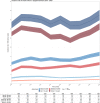Risk factors for incident heart failure in age- and sex-specific strata: a population-based cohort using linked electronic health records
- PMID: 30618162
- PMCID: PMC7074015
- DOI: 10.1002/ejhf.1350
Risk factors for incident heart failure in age- and sex-specific strata: a population-based cohort using linked electronic health records
Abstract
Aims: Several risk factors for incident heart failure (HF) have been previously identified, however large electronic health records (EHR) datasets may provide the opportunity to examine the consistency of risk factors across different subgroups from the general population.
Methods and results: We used linked EHR data from 2000 to 2010 as part of the UK-based CALIBER resource to select a cohort of 871 687 individuals 55 years or older and free of HF at baseline. The primary endpoint was the first record of HF from primary or secondary care. Cox proportional hazards analysis was used to estimate hazard ratios for associations between risk factors and incident HF, separately for men and women and by age category: 55-64, 65-74, and > 75 years. During 5.8 years of median follow-up, a total of 47 987 incident HF cases were recorded. Age, social deprivation, smoking, sedentary lifestyle, diabetes, atrial fibrillation, chronic obstructive pulmonary disease, body mass index, haemoglobin, total white blood cell count and creatinine were associated with HF. Smoking, atrial fibrillation and diabetes showed stronger associations with incident HF in women compared to men.
Conclusion: We confirmed associations of several risk factors with HF in this large population-based cohort across age and sex subgroups. Mainly modifiable risk factors and comorbidities are strongly associated with incident HF, highlighting the importance of preventive strategies targeting such risk factors for HF.
Keywords: Electronic health records; Heart failure; Incidence; Population attributable risk; Risk factors.
© 2019 The Authors. European Journal of Heart Failure published by John Wiley & Sons Ltd on behalf of European Society of Cardiology.
Figures


Similar articles
-
Dietary Patterns and Incident Heart Failure in U.S. Adults Without Known Coronary Disease.J Am Coll Cardiol. 2019 Apr 30;73(16):2036-2045. doi: 10.1016/j.jacc.2019.01.067. J Am Coll Cardiol. 2019. PMID: 31023426 Free PMC article.
-
Modifiable Risk Factors for Incident Heart Failure in Atrial Fibrillation.JACC Heart Fail. 2017 Aug;5(8):552-560. doi: 10.1016/j.jchf.2017.04.004. Epub 2017 Jun 14. JACC Heart Fail. 2017. PMID: 28624486 Free PMC article. Clinical Trial.
-
Pro-adrenomedullin as an independent predictive biomarker for heart failure in atrial fibrillation and flutter.ESC Heart Fail. 2025 Jun;12(3):1893-1904. doi: 10.1002/ehf2.15196. Epub 2025 Jan 13. ESC Heart Fail. 2025. PMID: 39801263 Free PMC article.
-
Association of Life's Essential 8 with incidence of heart failure modified by depressive symptoms: a prospective cohort study from UK Biobank.BMC Med. 2025 Mar 24;23(1):175. doi: 10.1186/s12916-025-04011-3. BMC Med. 2025. PMID: 40128779 Free PMC article.
-
A population-based study of 92 clinically recognized risk factors for heart failure: co-occurrence, prognosis and preventive potential.Eur J Heart Fail. 2022 Mar;24(3):466-480. doi: 10.1002/ejhf.2417. Epub 2022 Jan 26. Eur J Heart Fail. 2022. PMID: 34969173 Free PMC article.
Cited by
-
Genome-wide association analysis and Mendelian randomization proteomics identify drug targets for heart failure.Nat Commun. 2023 Jul 10;14(1):3826. doi: 10.1038/s41467-023-39253-3. Nat Commun. 2023. PMID: 37429843 Free PMC article.
-
Risk Factors for Heart Failure in the Community: Differences by Age and Ejection Fraction.Am J Med. 2020 Jun;133(6):e237-e248. doi: 10.1016/j.amjmed.2019.10.030. Epub 2019 Nov 17. Am J Med. 2020. PMID: 31747542 Free PMC article.
-
Risk factors for pre-heart failure or symptomatic heart failure based on NT-proBNP.ESC Heart Fail. 2023 Feb;10(1):90-99. doi: 10.1002/ehf2.14149. Epub 2022 Sep 24. ESC Heart Fail. 2023. PMID: 36151844 Free PMC article.
-
Sex-Specific Associations of Cardiovascular Risk Factors and Biomarkers With Incident Heart Failure.J Am Coll Cardiol. 2020 Sep 22;76(12):1455-1465. doi: 10.1016/j.jacc.2020.07.044. J Am Coll Cardiol. 2020. PMID: 32943164 Free PMC article.
-
NETosis as a Pathogenic Factor for Heart Failure.Oxid Med Cell Longev. 2021 Feb 23;2021:6687096. doi: 10.1155/2021/6687096. eCollection 2021. Oxid Med Cell Longev. 2021. PMID: 33680285 Free PMC article. Review.
References
-
- George J, Rapsomaniki E, Pujades‐Rodriguez M, Shah AD, Denaxas S, Herrett E, Smeeth L, Timmis A, Hemingway H. How does cardiovascular disease first present in women and men? Incidence of 12 cardiovascular diseases in a contemporary cohort of 1,937,360 people. Circulation 2015;132:1320–1328. - PMC - PubMed
-
- Ponikowski P, Voors AA, Anker SD, Bueno H, Cleland JG, Coats AJ, Falk V, Gonzalez‐Juanatey JR, Harjola VP, Jankowska EA, Jessup M, Linde C, Nihoyannopoulos P, Parissis JT, Pieske B, Riley JP, Rosano GM, Ruilope LM, Ruschitzka F, Rutten FH, van der Meer P. 2016 ESC Guidelines for the diagnosis and treatment of acute and chronic heart failure: the Task Force for the diagnosis and treatment of acute and chronic heart failure of the European Society of Cardiology (ESC). Developed with the special contribution of the Heart Failure Association (HFA) of the ESC. Eur J Heart Fail 2016;18:891–975. - PubMed
-
- Bleumink GS, Knetsch AM, Sturkenboom MC, Straus SM, Hofman A, Deckers JW, Witteman JC, Stricker BH. Quantifying the heart failure epidemic: prevalence, incidence rate, lifetime risk and prognosis of heart failure. The Rotterdam Study. Eur Heart J 2004;25:1614–1619. - PubMed
-
- Koudstaal S, Pujades‐Rodriguez M, Denaxas S, Gho JM, Shah AD, Yu N, Patel RS, Gale CP, Hoes AW, Cleland JG, Asselbergs FW, Hemingway H. Prognostic burden of heart failure recorded in primary care, acute hospital admissions, or both: a population‐based linked electronic health record cohort study in 2.1 million people. Eur J Heart Fail 2017;19:1119–1127. - PMC - PubMed
-
- Butler J, Kalogeropoulos AP, Georgiopoulou VV, Bibbins‐Domingo K, Najjar SS, Sutton‐Tyrrell KC, Harris TB, Kritchevsky SB, Lloyd‐Jones DM, Newman AB, Psaty BM. Systolic blood pressure and incident heart failure in the elderly. The Cardiovascular Health Study and the Health, Ageing and Body Composition Study. Heart 2011;97:1304–1311. - PMC - PubMed
Publication types
MeSH terms
Grants and funding
LinkOut - more resources
Full Text Sources
Medical
Research Materials
Miscellaneous

